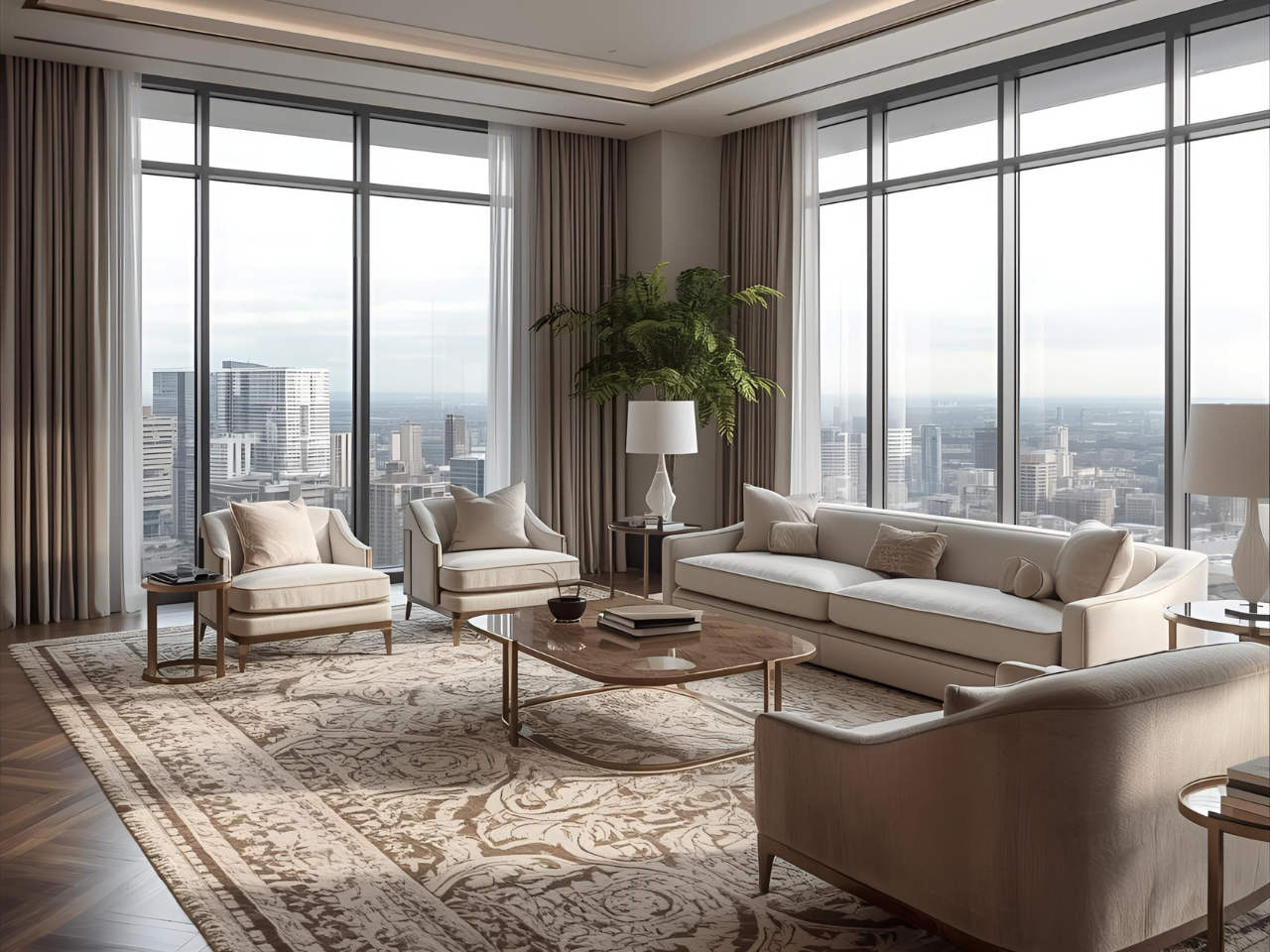A rug can make or break a room. More than just a soft surface underfoot, a well-chosen rug or carpet is a foundational element that can define the entire atmosphere of your space. While it might seem like a finishing touch, top interior designers know that the right rug is a strategic investment, not an afterthought. Choosing one requires the same care and planning as selecting a sofa or a dining table.
This guide provides expert recommendations from top interior designers on how to buy carpets and rugs the right way. We’ll walk you through everything from measuring your space to selecting materials, ensuring your final choice enhances your home for years to come.
Why Buying Rugs and Carpets Requires a Strategy
Choosing a rug is a significant decision with a long-term impact on your home’s interior. As a major investment, it sets the tone for comfort, style, and luxury. A beautiful, high-quality rug can anchor a room, pull together disparate design elements, and add a layer of warmth and texture.
Conversely, getting it wrong can disrupt the entire flow of a room. A rug that is too small can make a space feel disjointed, while one with a clashing pattern can create visual chaos. By approaching your purchase with a clear strategy, you can avoid common pitfalls and find a piece that truly elevates your decor.
Top Interior Designer Recommendations Before Buying
Before you start browsing, designers recommend a few crucial planning steps. Taking the time to consider these factors will streamline your search and lead to a more successful purchase.
1. Measure Your Space First
One of the most common mistakes homeowners make is choosing a rug that’s the wrong size. A rug that is too small can make your furniture look like it’s floating aimlessly, while an oversized one can overwhelm the room. Measure the entire room, as well as the area you want the rug to cover. As a general rule, a rug should be large enough to sit under the front legs of your main furniture pieces to create a cohesive, anchored look.
2. Think Function and Aesthetics
How will the room be used? A rug in a high-traffic area like a hallway or living room needs to be durable enough to withstand daily wear. In contrast, a bedroom rug can be plusher and more delicate. Consider both the practical function and the visual style you want to achieve.
3. Prioritize Material
The material of your rug affects its look, feel, and longevity.
- Wool: A designer favorite for its durability, softness, and natural stain resistance. It’s an excellent choice for living rooms and other high-traffic zones.
- Silk: Known for its luxurious sheen and fine texture, silk is best suited for low-traffic areas like bedrooms where its delicate beauty can be appreciated.
- Jute & Sisal: These natural fibers offer a rustic, textured look and are quite durable, making them good for layered looks or casual spaces.
- Synthetics: Materials like polypropylene and nylon are budget-friendly, highly durable, and easy to clean, making them ideal for homes with kids and pets.
4. Consider Your Lifestyle
Your daily life should heavily influence your rug choice. Do you have children or pets? If so, opt for stain-resistant and easy-to-clean materials. Suffer from allergies? Look for low-pile or natural-fiber rugs that don’t trap as much dust. Your climate can also play a role; a thick wool rug adds warmth in a cold environment, while a flatweave is better for warmer regions.
5. Balance Budget and Quality
Rugs are available at a wide range of price points. While it’s tempting to save money, a high-quality, handmade rug from a brand like The Ambiente can last a lifetime, making it a worthwhile investment. Decide where you can afford to invest—such as a statement piece for the living room—and where you can save, like a simple runner for a hallway.
How to Choose Rugs & Carpets by Room
Each room has unique needs. Here’s how designers approach rug selection for different areas of the home.
- Living Room Rugs: The rug should anchor the main seating area. Ensure it’s large enough to fit under the front legs of your sofa and chairs to unify the space.
- Bedroom Rugs: A soft, plush rug adds warmth and comfort. Place it under the bed so you have a cozy surface to step onto in the morning.
- Dining Room Rugs: The rug should extend at least 24 inches beyond the table on all sides. This allows chairs to be pulled out without catching on the rug’s edge.
- Hallways & Entryways: These high-traffic areas require durable runners that can withstand constant use.
- Work Corners & Offices: Use a rug to define your workspace within a larger room, adding a professional and comfortable touch.
Common Mistakes to Avoid: Designer Warnings
Even with a plan, it’s easy to make a misstep. Designers flag these common errors:
- Choosing size based only on furniture: Always consider the entire room’s layout, not just the furniture arrangement.
- Ignoring rug pads: A quality rug pad prevents slipping, protects your floor, and extends the life of your rug.
- Falling for trendy patterns: A rug is a long-term investment. Choose a design that aligns with your overall style, not a fleeting trend.
- Overlooking maintenance: Before buying, understand the cleaning requirements. A beautiful silk rug may be impractical if it needs constant professional care.
Find Your Perfect Foundation
Buying a rug should be a thoughtful process, planned with the same attention you give to your furniture. By combining practicality with aesthetics and thinking long-term, you can find a piece that not only looks beautiful but also stands the test of time.
Ready to find a rug that tells a story? Explore The Ambiente’s curated collection of sustainable, handmade rugs to bring authenticity and elegance into your home.
Frequently Asked Questions
Q: How do I choose the right size rug for my living room?
A: Measure your space carefully, ensuring the rug anchors your furniture without being too small or oversized. Ideally, it should sit under the front legs of your sofa and accent chairs.
Q: What materials are best for high-traffic areas?
A: Durable materials like wool or high-quality synthetic fibers are excellent choices for high-traffic areas because they are resilient and easier to clean.
Q: How can I ensure my rug complements my existing decor?
A: Consider the color palette, patterns, and style of your room. Choose a rug that harmonizes with these elements, either by picking up on existing colors or providing a neutral foundation.
Q: Are sustainable and eco-friendly rug options available?
A: Yes, many brands now offer sustainable options. Look for rugs made from natural, renewable materials like wool, jute, or organic cotton, and produced using ethical practices.
Q: How do I care for and maintain my new rug to ensure longevity?
A: Regular vacuuming, prompt stain removal, and periodic professional cleaning are essential for maintaining your rug’s appearance and lifespan. Using a rug pad also helps.





